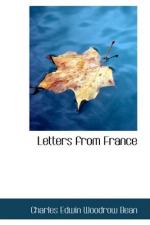The German line on the hill-crest was attacked as soon as ever the village was properly cleared. The Australians went at it in the night across a wide strip of waste hill-top. The thistles there, and the brown earth churned up in shell craters, and the absolute absence of any kind of movement (simply because it was too dangerous to move), call to one’s mind Shakespeare’s old stage direction of a “blasted heath.” There had been a short artillery preparation; the attack reminded one of our old raids up on the Armentieres front.
I have seen Germans who were in the line in front of that attack. They state that they were not surprised. In the light of their flares they had seen numbers of “Englishmen” advancing over the shoulder of the hill. When the rush came, one German officer told me, he, in his short sector of the line alone, had three machine-guns all hard at work. The attack reached the remnants of the German wire. Some brave men picked a path through the tangle, and, in spite of the cross-fire, managed to reach the German trench. They were very few. We have since discovered men in the craters even beyond the front German trench. The German officer told me that his men had afterwards found an Australian who had been lying in a crater in front of his line for four days. He had been shot through the abdomen and had a broken leg, but he had been brought in by the Germans and was doing well. We also afterwards brought in both Australians and Germans who had been out there for six days, wounded, living on what rations they had with them.
It was a brave attack. On the extreme left it succeeded. But the trenches won by the Victorians there were on the flank, not on the hill-top. The country behind that crest, sloping gradually down to the valley of Courcelette and beyond, where the German field batteries were firing and where the Germans could come and go unseen—all this was so far an unknown land into which no one on the British side had peered since the battle began.
Six days later the Australians went for that position again. They attacked just after dusk. There was enough light to make out the face of the country as if by a dim moonlight. They were the same troops who had made the attack a week before, because there was a determination that they, and they alone, should reach that line. The artillery had been pounding it gradually during the week.
The German troops who were holding that part were about to be relieved. They had suffered from the slow, continual bombardment. There were deep dug-outs in their trenches, where they saved the men as far as possible, but one after another these would be crushed or blocked by a heavy shell. The tired companies had lost in some cases actually half their men by this shell fire, losing them slowly, day by day, as a man might bleed to death. The remainder had their packs made up ready to march out to rest. The young officer of one of the relieving battalions was actually coming into the trenches at the head of his platoon—when there crashed on them a sudden hail of shell fire. The officer extended his men hurriedly and pushed on. It was about half-past ten by German time, which is half-past nine by ours.




